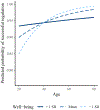Emotion dynamics across adulthood in everyday life: Older adults are more emotionally stable and better at regulating desires
- PMID: 32191090
- PMCID: PMC8267403
- DOI: 10.1037/emo0000734
Emotion dynamics across adulthood in everyday life: Older adults are more emotionally stable and better at regulating desires
Abstract
Older adults report experiencing improved emotional health, such as more intense positive affect and less intense negative affect. However, there are mixed findings on whether older adults are better at regulating emotion-a hallmark feature of emotional health-and most research is based on laboratory studies that may not capture how people regulate their emotions in everyday life. We used experience sampling to examine how multiple measures of emotional health, including mean affect, dynamic fluctuations between affective states and the ability to resist desires-a common form of emotion regulation-differ in daily life across adulthood. Participants (N = 122, ages 20-80) reported how they were feeling and responding to desire temptations for 10 days. Older adults experienced more intense positive affect, less intense negative affect, and were more emotionally stable, even after controlling for individual differences in global life satisfaction. Older adults were more successful at regulating desires, even though they experienced more intense desires than younger adults. In addition, adults in general experiencing more intense affect were less successful at resisting desires. These results demonstrate how emotional experience is related to more successful desire regulation in everyday life and provide unique evidence that emotional health and regulation improve with age. (PsycInfo Database Record (c) 2021 APA, all rights reserved).
Figures




References
-
- Bates D, Mächler M, Bolker B, & Walker S (2015). Fitting Linear Mixed-Effects Models Using lme4. Journal of Statistical Software, 67(1), 1–48.
-
- Baumeister RF, & Vohs KD (Eds.). (2004). Handbook of self-regulation: Research, theory, and applications. New York, NY, US: The Guilford Press.
-
- Boals, vanDellen, & Banks, 2011) The relationship between self-control and health: The mediating effect of avoidant coping, Psychology & Health, 26:8, 1049–1062. - PubMed
-
- Cacioppo JT, & Berntson GG (1994). Relationship between attitudes and evaluative space: A critical review, with emphasis on the separability of positive and negative substrates. Psychological Bulletin, 115(3), 401–423.
MeSH terms
Grants and funding
LinkOut - more resources
Full Text Sources
Other Literature Sources

